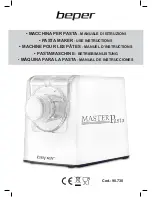
7
How the Freestanding Ice Maker Produces Ice
After the unit is powered on, the ice maker begins with rotating the ice case into a horizontal water fill
position under the evaporator rods. The water pump is engaged and fills the ice case with water. Water
overflows for a few seconds before the compressor turns on. The compressor then pumps refrigerant
and the fan will turn on automatically after the condenser heats up. The unit will be producing bullet
shaped ice around the stainless steel evaporator rods. When the batch of ice has been fully formed, the
ice maker stops the freeze cycle and begins the harvest cycle. A valve opens diverting hot refrigerant
gas into the evaporator rods. The gas heats the rods, causing the ice cube bullets to slide off the
evaporator. The hinged ice case will move out of the way for the formed ice cubes to drop onto the slide
and be deposited into the ice bin. The ice case will then resume its horizontal position and be filled with
water for the next batch of ice to be made. The ice maker will then produce ice until ice reaches the ice
full sensor. Once enough of the ice has melted, the ice maker will automatically start making more ice.
The ice maker is insulated but not refrigerated. Harvested ice will slowly melt and drain through the
gravity drain. The ice maker will automatically begin making more ice.
Installing the Water Line
The direct water line can be installed into the ice maker for a continuous flow of water, preventing you
from refilling a water tank every time you need more ice. The ice maker is designed with a direct water
line for continuous operation. The internal ice tray does not require manual filling.
NOTE: All the required or customized hardware is not provided for installation so it is necessary to hire
a professional licensed plumber to complete the installation.
1. Connect the water line to your water source and be sure to tighten the connection to avoid leaking.
2. Hand screw the water line into the water inlet valve on the back of the ice maker.
3. Connect the drainage tube on water outlet valve.
4. Lightly tighten the compression fitting around the water line with an adjustable wrench or similar
tool.































